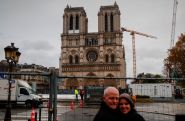
The restoration of Notre-Dame is progressing: the finalist artists for the contemporary stained glass have been heard, while a new, resolutely modern reliquary has been unveiled to house the precious Crown of Thorns of Christ.
Nearly four years after the devastating fire that ravaged Notre-Dame de Paris on April 15, 2019, the restoration project is in full swing. Two significant events mark this pivotal week: the hearing of the finalist artists for the design of the new contemporary stained glass and the presentation of the new reliquary intended to hold the Holy Crown of Thorns.
On Wednesday, November 6, the eight artists, each paired with a glass workshop, presented their projects for the five windows in the cathedral's southern aisle to a 20-member artistic committee. Jean-Michel Alberola, Daniel Buren, Yan Pei-Ming, Gérard Traquandi, Claire Tabouret, Philippe Parreno, Christine Safa, and Flavie Vincent-Petit were selected from 110 applicants following a call for entries in April.
Their mission: to design contemporary stained glass to replace the 19th-century “grisaille” windows by Viollet-Le-Duc, while maintaining a “figurative” style and a “neutral light.” The chosen theme is Pentecost. The winning artist(s), to be announced soon, will present a prototype in time for the reopening of Notre-Dame, scheduled for December 7-8. The new stained glass windows are expected to be installed by 2026.
This project, supported by the Archbishop of Paris, Mgr Laurent Ulrich, but met with a consultative unfavorable opinion from the National Heritage and Architecture Commission, remains divisive. A petition launched by Didier Rykner, head of La Tribune de l'Art, has gathered nearly 235,000 signatures. The association Sites & Monuments even plans to take legal action, arguing that an international charter generally prohibits replacing existing works with new creations. This debate echoes the controversies sparked by the Louvre Pyramid or Buren's Columns at the Palais Royal.
Meanwhile, another treasure of Notre-Dame’s collection is preparing to return to the cathedral: the precious Crown of Thorns, which Christian tradition identifies as the one placed on Christ's head before his crucifixion. Saved in extremis from the fire by firefighters who had to break its glass case, it will soon be displayed in a new, strikingly modern reliquary.
Designed by Sylvain Dubuisson and crafted by Les Ateliers Saint-Jacques & Fonderie de Coubertin, this cedar wood “reliquary wall” appears as a large 3.60 by 2.60-meter altarpiece adorned with bronze thorns symbolizing Christ's suffering. At its center, a deep blue semi-sphere set within a glass halo will house the Holy Crown.
“The inspiration was to create a large cedar wood altarpiece with an embedded glass cabochon halo, with the crown relic presented in the center,” explains Dubuisson. A majestic setting that “tells, through its grandeur and scope, that we are in front of an important object” and “draws attention not to itself but to center us on the presence of this crown of thorns,” adds Guillaume Normand, vice-rector of the cathedral.
Positioned along the nave's axis, this reliquary will “not be visible from the outside but something to discover while walking through the interior of the cathedral.” Its arrival is expected at the end of November, followed by a blessing by the archbishop during the inaugural week after the eagerly awaited reopening of the edifice.
Whether stained glass or reliquary, these contemporary creations aim to integrate into the long history of this Gothic gem as the monumental restoration nears its completion. A bold endeavor for this historic monument, visited each year by millions from around the world, which will reopen its doors on December 8, 2024—over five years after narrowly escaping destruction. Notre-Dame thus begins its rebirth, balancing faithful restoration and contemporary creation to continue evolving, as it has always done through the centuries.
With AFP


Comments